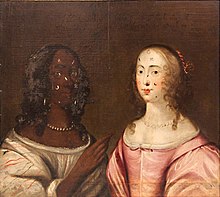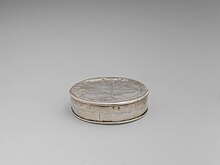Beauty mark

A beauty mark or beauty spot is a euphemism for a type of dark facial mark so named because such birthmarks are sometimes considered an attractive feature.[1] Medically, such "beauty marks" are generally melanocytic nevus, more specifically the compound variant. Moles of this type may also be located elsewhere on the body, and may also be considered beauty marks if located on the face, shoulder, neck or breast. Artificial beauty marks have been fashionable in some periods.
Artificial beauty marks[edit]

History[edit]
The wearing of artificial beauty marks trace back to the Roman Empire; it was believed that the Goddess of beauty, Venus, had a single beauty mark that accentuated her beauty.[3] As such, beauty patches became a recognizable symbol of beauty designed to highlight the pale, unblemished skin of the wearer.[4] In Europe, mouches (French, 'flies'), became fashionable in sixteenth-century France, and the fashion persisted into the eighteenth century. When the fashion spread to Spain and the Spanish Empire they were called a chiqueador.[5]


A mouche was generally made of paper, silk or velvet and was applied to the face as a form of make-up. They were kept in a patch box, or boîte à mouches ('box of flies'), and were often fanciful shapes such as hearts or stars. Patch boxes were often ornate, silver boxes, and formed an essential part of a woman's boudoir. Fashion prints from the late seventeenth century show women with an increasing number of beauty marks in a variety of sizes and shapes, placed on the cheeks, chins, and forehead.
Besides their decorative value, the patches could hide smallpox scars or syphilis sores, as well as acne.[5] In 1668, the English diarist Samuel Pepys recorded attending the theatre and witnessing Barbara Villiers, one of the King's mistresses "called to one of her women… for a little patch off her face, and put it into her mouth and wetted it, and so clapped it upon her own by the side of her mouth, I suppose she feeling a pimple rising there."[6] Contemporary satire or beauty manuals like R. Smith's A Wonder of Wonders: or, a Metamorphosis of fair Faces voluntarily transformed into foul Visages attested the wearing of patches could "turn botches into beauty."[3]
By the eighteenth-century, the wearing of patches also adopted social and political meaning. The placement or shape of a patch could reveal information about then wearer's relationship status, sexual availability, or political affiliations.
Alexander Pope's 1712 poem The Rape of the Lock mentions such patches as indicators of "secular love":[7]
Here Files of Pins extend their shining Rows,
Puffs, Powders, Patches, Bibles, Billet-doux.
Now awful Beauty puts on all its Arms;
The Fair each moment rises in her Charms,
Repairs her Smiles, awakens ev'ry Grace,
And calls forth all the Wonders of her Face;
Criticism of the beauty patch[edit]
Moral commentators in the early modern period increasingly expressed concern about the wearing of beauty patches, and linked it to sexual immorality and prostitution. The British diarist and intellectual John Evelyn referred to the wearing of patches, and make-up more general, as a "most ignominious thing."[8] Other commentators saw the wearing of a black patch as a physical symbol of the wearers black morals, or soul, commonly attributing the wearing of patches to signs of the wearer's vanity.[9] However, despite moral outcry, patches continued to be worn by men and women of diverse social ranks.
Contemporary beauty patches[edit]
The Monroe piercing has gained popularity in recent years as a flexible way of approximating a beauty mark.[citation needed] Natural beauty marks are also often enhanced with color from an eyebrow pencil or pen.[10] Modern day acne patches can also be considered a new form of the beauty patch, turning a physical imperfection into a fashionable accessory. This is particularly true for new styles of pimple patches that come in fashionable shapes and colors, including stars, hearts, and clouds.[citation needed]
Celebrities with beauty marks[edit]
Many female sex symbols, actresses, and other celebrities are known for their beauty marks:[10][11][12]
- Gloria Swanson, born 1899
- Arlene Dahl, born 1925
- Jean Patchett, born 1926
- Marilyn Monroe, born 1926
- Anne Francis, born 1930
- Elizabeth Taylor, born 1932
- Sophia Loren, born 1934
- Tina Louise, born 1934
- Edie Sedgwick, born 1943
- Dolly Parton, born 1946
- Kate Pierson, born 1948
- Lynsey de Paul, born 1948
- Paloma Picasso, born 1949
- Christine Baranski, born 1952
- Kim Cattrall, born 1956
- Geena Davis, born 1956
- Madonna, born 1958
- Elizabeth Perkins, born 1960
- Sheryl Crow, born 1962
- Paula Abdul, born 1962
- Michelle Forbes, born 1965
- Cindy Crawford, born 1966
- Janet Jackson, born 1966
- Julia Roberts, born 1967
- Lisa Marie Presley, born 1968
- Mariah Carey, born 1969
- Lil' Kim, born 1974
- Eva Mendes, born 1974
- Mel B, born 1975
- Rachel McAdams, born 1978
- Pink, born 1979
- Sarah Buxton, born 1980
- Natalie Portman, born 1981
- Erin Wasson, born 1982
- Mandy Moore, born 1984
- Caroline Polachek, born 1985
- Lady Gaga, born 1986
- INNA, born 1986
- BC Jean, born 1987
- AJ Lee, born 1987
- Blake Lively, born 1987
- Ronda Rousey, born 1987
- Brie Larson, born 1989
- Aly Michalka, born 1989
- Charli XCX, born 1992
- Karlie Kloss, born 1992
- Neelam Muneer, born 1992
- Kate Upton, born 1992
- Frida Gustavsson, born 1993
- Phoebe Dynevor, born 1995
- Dua Lipa, born 1995
- Son Chaeyoung, born 1999

Male actors known for their beauty marks include:[10]
- George Hamilton, born 1939
- Robert De Niro, born 1943
- Ewan McGregor, born 1971
- Ben Affleck, born 1972
- Joaquin Phoenix, born 1974
- Tobey Maguire, born 1975
- Colin Farrell, born 1976
- Adam Driver, born 1983
In fiction[edit]
In the conclusion of the book The Silence of the Lambs, the heroine Clarice Starling gains an artificial beauty mark when burnt gunpowder gets lodged in the flesh of her cheek. She retains this mark in the sequel novel Hannibal. This symbolism (along with Dr. Lecter's polydactylism) did not get carried over into the film adaptations. [citation needed]
Joan Crawford had a prominent beauty mark in her role as Sadie Thompson in Rain.
Alicia Silverstone has a beauty mark on the left side of her mouth when portraying Batgirl in Batman and Robin.
In the Kiff episode "Two Truths and a Bunny", Kennedy the lemur is confident that no one could top her in a game where one player must tell two facts and a fib, and the other participants must spot the fib. But Barry the rabbit, with some pointers from his sister, bests Kennedy in the game after Kennedy gives three statements which Barry finds out are all fibs. Barry then removes Kennedy's beauty mark which is actually a raisin.[13]
See also[edit]
References[edit]
- ^ Ariel, Irving M. (1981). A Historical Introduction: Is the beauty mark a mark of beauty or a potentially dangerous cancer? Malignant Melanoma, Appleton-Century-Crofts, ISBN 978-0-8385-6114-0
- ^ Capon, Alex (28 June 2021). "Pick of the week: £220,000 for enigmatic faces of the Interregnum". Antiques Trade Gazette. Retrieved 4 July 2021.
- ^ a b Hearn, Karen (2015). "Revising the Visage: Patches and Beauty Spots in Seventeenth-Century British and Dutch Painted Portraits" (PDF). Huntington Library Quarterly. 78: 809–823 – via JSTOR.
- ^ Ribeiro, Aileen (2011). Facing beauty: painted women & cosmetic art. New Haven [Conn.]: Yale University Press. ISBN 978-0-300-12486-6.
- ^ a b "Beauty Marks Go Global", ARTicle, blog of the Art Institute of Chicago, January 14, 2015 Archived August 26, 2018, at the Wayback Machine
- ^ "Tuesday 5 May 1668". The Diary of Samuel Pepys. 2011-05-05. Retrieved 2023-11-22.
- ^ "Pope: Rape of the Lock". University of St Andrews. 16 March 1999. Retrieved 1 December 2013.
- ^ Evelyn, John (2013-02-12). Bray, William (ed.). The Diary of John Evelyn (Volume 2 of 2).
- ^ Reichardt, Dosia. ""Their faces are not their own": Powders, patches and paint in seventeenth-century poetry". Dalhousie Review. 84 (2): 201.
- ^ a b c Barbara Cloud, "Marks of Distinction", Chicago Tribune, April 25, 1990.
- ^ Schulte-Hillen, Sophie (August 14, 2017). "The 9 Greatest Beauty Marks of All Time, from Cindy Crawford to Madonna". Vogue.
- ^ White, Jackie (April 30, 1995). Behind the glamour lurks an ugly, dirty business. Kansas City Star
- ^ "Two Truths and a Bunny". Kiff. Season 1. Episode 12. July 2023. Disney Channel.
